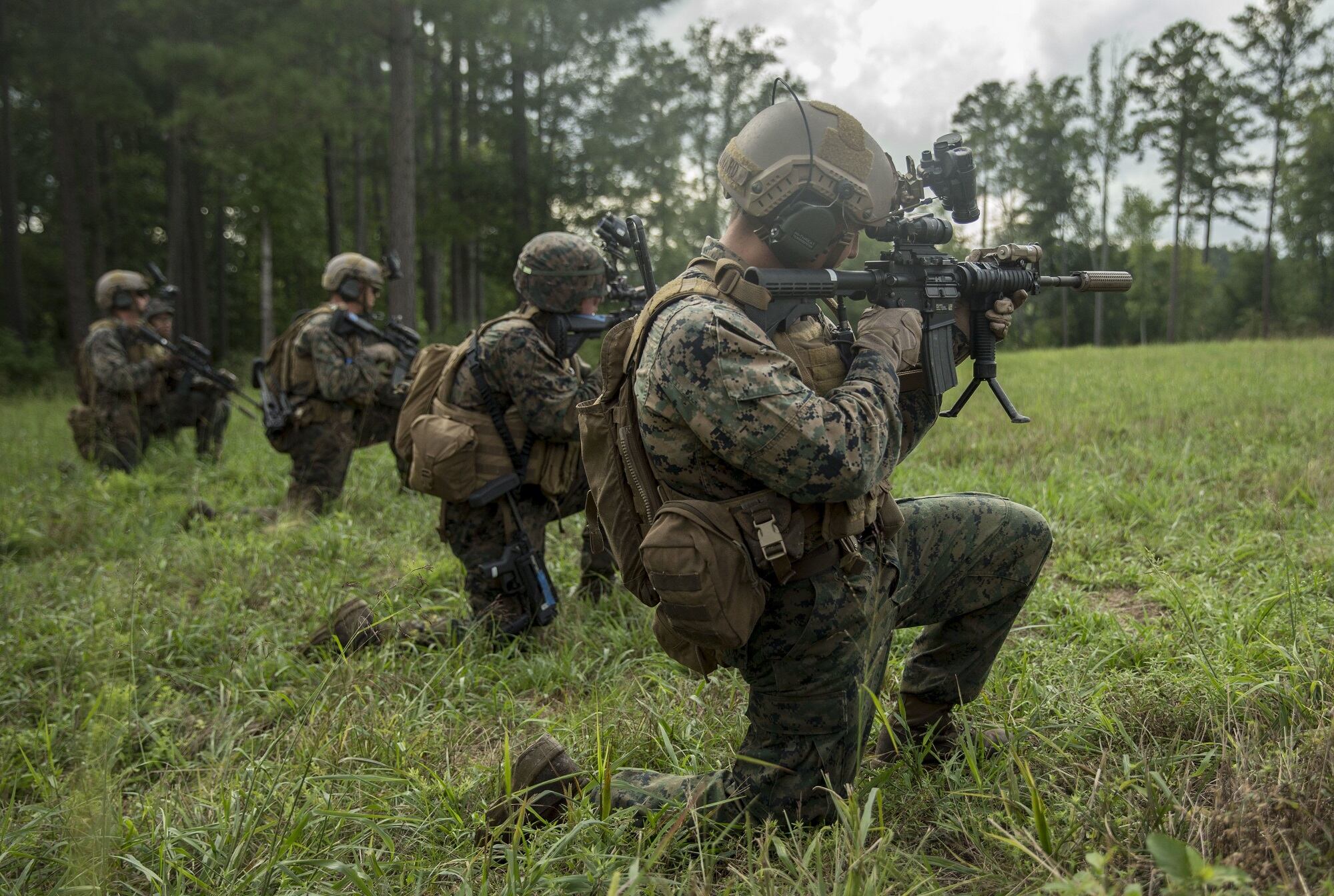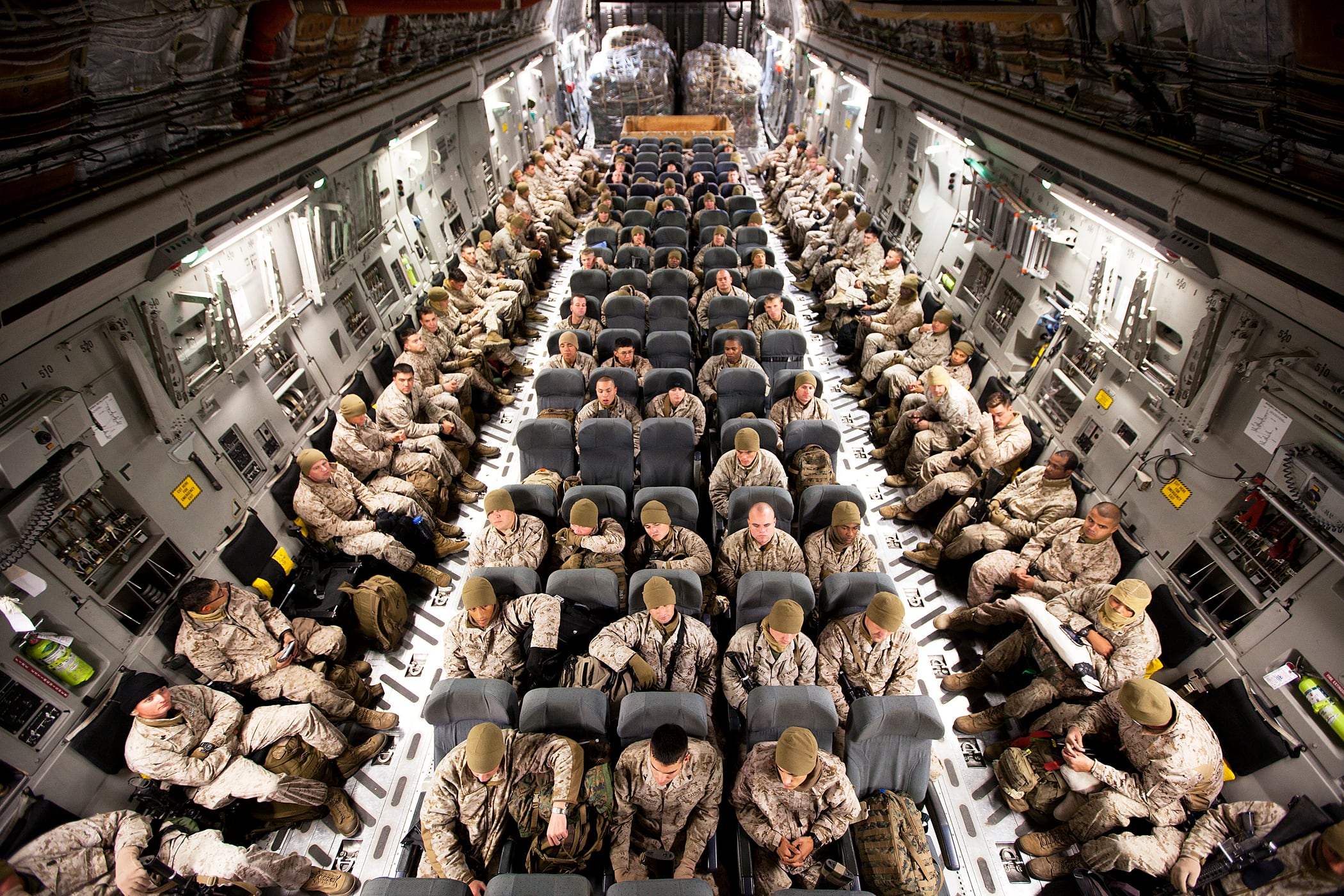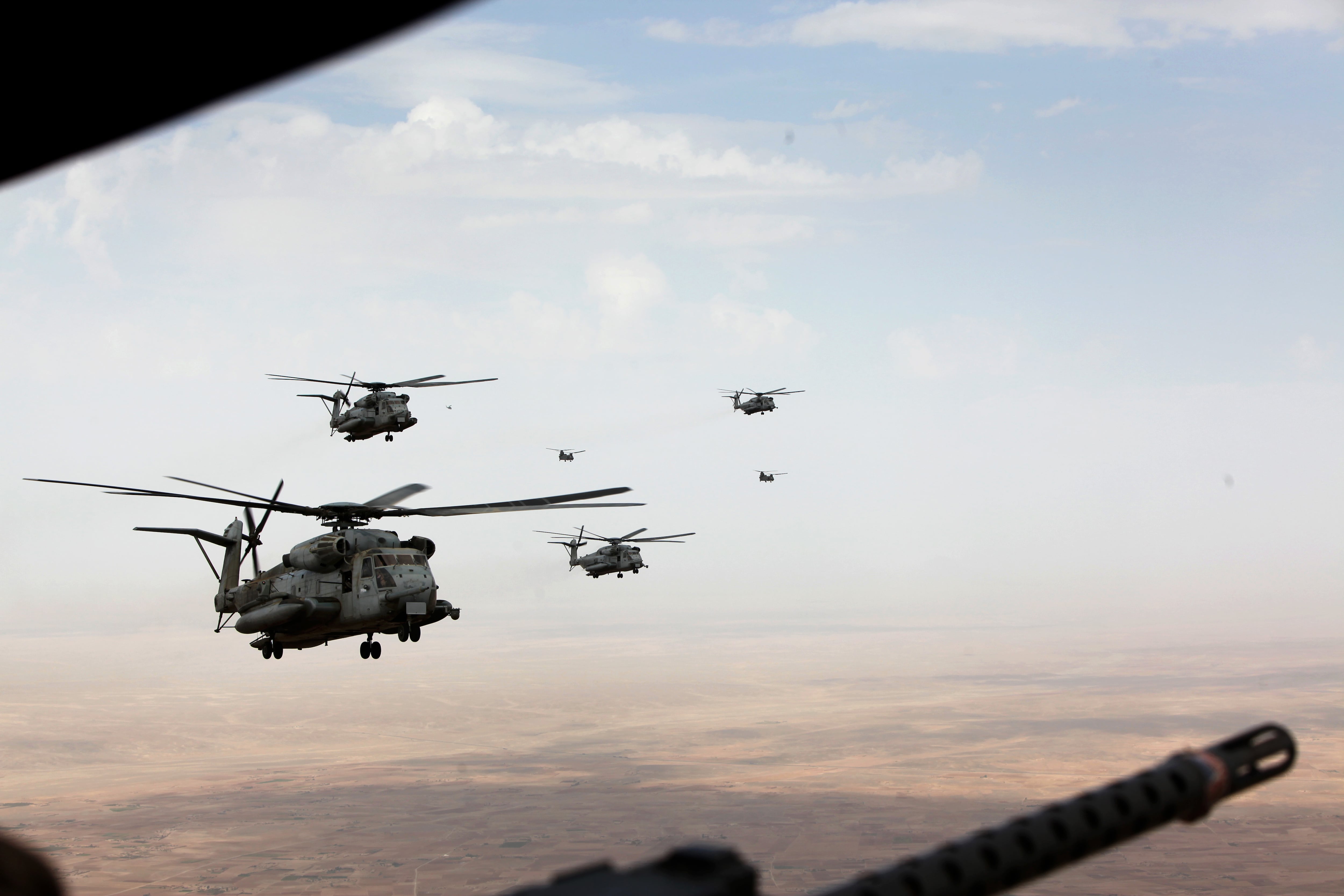Marine Corps Commandant Gen. Robert Neller has repeatedly offered sobering — and at times ominous — warnings about the next war the Corps will face.
He says the next fight will be far more complex and deadly than the campaigns in Iraq and Afghanistan that have shaped the force and its leadership over the past 16 years.
“I don’t think the next fight is going to be a stability op/counterinsurgency: It’s going to be a violent, violent fight,” Neller said in May, while speaking at the 2017 Innovation Symposium awards ceremony.
In June, Neller told Congress that, right now, the Marine Corps is “not currently organized, trained and equipped to face a peer adversary in the year 2025.”
The commandant has good reason to worry. Military planners expect future enemies to have advanced air and shore defenses. They will have effective aircraft and indirect fire. They will use cyber and electronic warfare to jam or confuse Marines’ networks, communications systems and global positioning systems.
The opening salvos of future wars will likely be fired in space, Neller believes.
“In my view, the recon/counterrecon fight is going to start not by taking out recon teams and shooting down surveillance aircraft. It’s going to start in cyber and space — to blind the enemy, or to blind us,” Neller said in May.
“The center of gravity that we have to protect is the network, and the network is dependent on space. We lose space, we’re back to [high frequency] radio and yellow stickies on the map.”
Those concerns are shaping the way the Corps is investing in the future — boosting cyber and electronic warfare capabilities, psychological operations, air defenses and other nontraditional combat power that will be needed to prevail on future battlefields.
But Neller fears those new capabilities might not come fast enough.
“People ask me, ‘What are you worried about?’” Neller said at the awards ceremony. “I’m worried that we’re going too slow and that we’re afraid of change.”
NO MORE LOW-TECH ENEMIES
As the U.S. invasion of Afghanistan got underway in November 2001, Marines led by then-Brig. Gen. James Mattis flew more than 375 nautical miles from the amphibious assault ship Peleliu to secure an airstrip in southern Afghanistan — the deepest insertion of amphibious Marines to capture an airfield in the Corps’ history.
“It’s a perfect illustration of what the Corps had envisioned accomplishing: It deploys a force from the sea from long distance by air … and catches an enemy by surprise,” said Peter Singer, a strategist and senior fellow at the New America Foundation, a think tank in Washington, D.C.

“Part of what allowed them to do that is the amphibious force itself wasn’t under threat. It was a mobile base that could go anywhere the U.S. essentially wanted it to.”
Moreover, the Marines flying into Afghanistan in 2001 could be completely confident in the Corps’ communications networks, which essentially faced no major risk of disruption or cyberattack. Upon arrival in Afghanistan, the Marines enjoyed complete air superiority and the enemy there had no drone capabilities.
But the evolution of warfare has moved light-years since then. The advantages that the U.S. military has enjoyed in the decades following the 1991 Operation Desert Storm may simply not exist in the next battlespace. Future adversaries will be armed with deadlier technology — some of which may be better than what U.S. troops are armed with.
For the past 20 years, U.S. adversaries — from low-tech Iraqi insurgents to sophisticated military planners in Russia and China — have honed their own combat capabilities to undermine the American military and how it operates.
Many “attacks” that the Marines must prepare for will not be traditional kinetic strikes, Singer said. For example, the Chinese strategy calls for mounting a cyberattack on logistical support structures so that Marines in combat can’t get needed supplies. That could include hacking into the supply system to change bar codes so that Marines get toilet paper instead of ammunition.
“The idea is: I’m going to turn your strengths into weaknesses,” Singer told Marine Corps Times. “For the U.S. as a nation, they’ve looked at what are our unique strengths are: globalized, instantaneous information sharing and command and control; the second is a global basing and logistics structure.”
RELATED

FINDING A ‘BUBBLE’
The Marines historic mission of amphibious operations projecting power from the sea is now facing new threats not seen since August 1942, when the Japanese defeated the U.S. Navy at Savo Island, leaving Marines on Guadalcanal hung out to dry.
The range of enemy cruise and ballistic missiles is becoming greater than the distances that ship-based Marine aircraft can fly.
Both China and Russia are developing sophisticated air and coastal defenses known as anti-access area denial systems, which include carrier-killing cruise missiles, advanced air surface-to-air missiles and the latest fighter aircraft.
And some of those weapons and technology are spreading to the most low-tech enemies. For example, last year, the Houthi rebels in Yemen fired a cruise missile at a Navy destroyer in the Red Sea. The missile came within a minute of striking the ship and forced the destroyer to fire an interceptor missile. It’s widely believed that Iran provided the missiles to the Yemeni rebels.
The Marines are trying to avoid a strategy that requires the total destruction of those surface and air defense systems. Instead, the Marines’ plan is to use its own manned and unmanned systems to create temporary bubbles in enemy defenses, where amphibious landings can take place, according to the Marine Operating Concept.
“You’re going to have to set the conditions to where you can land the landing force, or you’re going have to find a place where you can land, where that threat may be nonexistent,” Neller said in 2016.
The Marine Corps is looking at how to use unmanned aircraft, submarines and vehicles to create diversions while Marines land elsewhere, according to the Ellis Group, the Corps’ internal think tank.
Another tactic the Corps is looking at is using swarms of unmanned aircraft to create a protective bubble around Marines as they come ashore, said Ellis Group Director Doug King.
“As soon as [an enemy] radiates, gives off a signature, that swarm is just going right after them,” King said in March.
RELATED

THE DRONE THREAT
Over the next 10 years, the greatest threat to U.S. Marines and other troops will be small, cheap drones, which even low-budget adversaries could potentially produce by the tens of thousands using 3-D printing.
“What you will have will be drones that are rounds of ammunition that fly to a specific area and then circle and look for a target — and use optical recognition out of something as simple as a cell phone camera to go after things,” said retired Marine Col. T. X. Hammes, a distinguished research fellow at the U.S. National Defense University.
China already has a drone based on an Israeli design that can reportedly fly 1,000 miles — almost twice the range of the F-35 — without refueling, he said. It comes in an 18-round launcher, so a company can launch 54 and a battalion can launch 162 of them.
Such drones are not just available to near-peer competitors, Hammes told Marine Corps Times. He noted that he was expressing his personal views, not those of the NDU or the Defense Department.
Nonstate extremist groups like al-Qaida or Hezbollah can purchase commercially available drones that can fly 2,000 miles, which can threaten both commercial and military aircraft.

Earlier this year, U.S. troops in Iraq reported that the Islamic State group was launching 10 to 15 drones a day against the Iraqi security forces fighting in Mosul, significantly slowing down the operation led by Iraqi troops. Combined with the threats posed by advanced Russian and Chinese cruise and ballistic missiles, enemy drones will pose a major threat to F-35 bases, Hammes said.
“The key question is whether DoD can shift from buying very, very expensive systems, like the F-35, to more useful systems, like inexpensive drones.”
“The danger with the F-35, of course, is it operates from a fixed airfield. Even the Marine version has to go back somewhere for maintenance. So we are investing heavily in the F-35, which is going to be extraordinarily vulnerable inside the decade.”
Small drones typically do not have large warheads, so Marines in hardened positions will be able to dig in and ride out a swarm attack by drones like an artillery barrage, he said.
But it will be harder for Marines who are on the move to defend against such attacks. While the Marine Corps is looking for ways to defeat enemy drones, the Defense Department’s procurement system is notoriously slow.
The U.S. can also use drones to great effect in defending Poland, the Baltic states, as well as treaty allies in the Pacific, such as Japan and the Philippines, Hammes said. The Polish military is already committed to buying 1,000 drones per year, which can carry high-explosive anti-tank and thermobaric warheads up to 20 kilometers, he said.
The U.S. Navy has developed a swarm drone launcher that can fit inside a 20-foot container, he said. If such systems were deployed in containers hauled by commercial trucks, they would be very hard for the Russians and Chinese to detect.
“We’re a status quo power, so we’re inherently on the defensive, and that’s good for us then because we’re defending the first island chain [off China’s coast] and we’re defending Eastern Europe,” Hammes said. “This stuff all works in our favor, if we use it.”
CYBERWARRIORS
There is growing concern inside the Marine Corps about ensuring the force has sufficient cyber capabilities, both offensive and defensive. Last year when Neller first began talking about the Trump campaign’s call for a larger Marine Corps, he specifically said he wanted more cyberwarriors rather than simply more infantry units.
Top-level officers have floated the idea of changing the Corps’ traditional standards and career paths to allow civilians with cyber skills to skip the junior ranks and enter the force from Day One as a staff sergeant.
The Marine Expeditionary Forces are reorganizing their headquarters groups to integrate offensive and defensive cyber operations into the fight, starting with I MEF Information Group, which officially stood up on July 6 at Camp Pendleton, California.
Over the next two to three years, the new group will add Marines to defend a Marine Air-Ground Task Force from cyberattacks and collect intelligence from the battlefield and space, said Col. Bobbi Shea, who led I MEF’s headquarters group when it became the information group.
Most of the new Marines will be assigned to the group’s information warfare and coordination center, which will function similar to a division’s combat operations center, said Shea, who has been frocked to brigadier general.
Ultimately, the new group is designed to give infantry Marines the tools they need to protect the network and go after the enemy’s communications, she said.
“It’s not just about growing a larger staff to coordinate and synchronize these capabilities,” she said. “It is about growing capacity so that we can more effectively attach these capabilities down at the infantry battalion — or even the combat logistics battalion level.”
The Marine Corps is also beginning to stand up electronic warfare support teams that will be “push[ed] down to our lowest level of formation that we provide to combat forces,” Brig. Gen. Dimitri Henry, Director of Intelligence for the Marine Corps, said in August.
“What they’re going to do is be able to employ those fires; electronic fires whether they be information operations or they be cyber operations, electronic warfare and the like,” Henry said.
Marine Corps officials said the decision to stand up these teams stems from the commandant’s decision to reshape the force for the “future operating environment.” He believes having a robust EW capability is a key component to fighting and winning future wars.
ENEMIES WITH BETTER GEAR
For the first time in decades, there’s a growing fear that U.S. troops could be outgunned on the battlefield by adversaries who have better and more effective weapons and gear.
Both Russia and China have already fielded battlefield technology that is better than U.S. troops’ kit, said Sen. Joni Ernst, an Iowa Republican and retired Army National Guard lieutenant colonel.
“Many of our near-peer competitors have better rifles, better sniper rifles than we do,” Ernst told Marine Corps Times. “China has a better sniper rifle. Russia has body armor that will stop our bullets.
Body armor that can stop 5.56 mm rounds fired by Marines and soldiers is available on the internet for as little as $250, Army Chief of Staff Gen. Mark Milley told lawmakers in May.
One of the most effective ways to tackle that problem is to change the way the Defense Department purchases and fields weapons.

The way the military buys its gear should be faster, less complex and more open to off-the-shelf commercial technology, Ernst said.
Meanwhile, the U.S. is being “almost outpaced” in cyber technology by Russia, China, North Korea and Iran, Ernst said. The military needs to determine what is an appropriate response to the type of cyber subterfuge tactics that Russia is known for, she said.
The Defense Department should also look at new applications for drones, such as using unmanned aircraft as defensive weapons, she said.
“You have incoming smart rounds that could be diverted by drones — that’s something that we need to look at,” Ernst said. “Anything that will enable us to protect our men and women in uniform in a combat zone or elsewhere — we need to be doing that, and it doesn’t have to be expensive in order to work.”
One way to make sure U.S. troops aren’t outgunned is by fielding commercially available technology that is available now instead of waiting years for the Defense Department to test and purchase new weapons systems through the traditional bureaucracy, Ernst said.
Terrorists and other bad guys do not have to go through the same cumbersome procurement process as the Defense Department, which typically takes years to produce weapons that may be out of date by the time they are fielded, she said.
“You have folks out there that can go buy [drones] off of Amazon or wherever inexpensively, and here we are as the United States dropping $1 million bombs from a $100 million aircraft onto a little pickup truck somewhere,” Ernst said. “We have to be smarter about the way we utilize technology.”
PREDICTING THE FUTURE
The Marine Corps is watching an array of potential flashpoints around the globe.
The obvious potential adversaries in a future war include China, Russia, Iran, North Korea and terrorist groups such as the Islamic State, but it is also possible that the U.S. could be caught completely by surprise, said retired Marine Lt. Col. Dakota Wood, now a military expert with the Heritage Foundation think tank in Washington.
“U.S. forces must maintain general competency in basic warfighting skills and the force maintained in sufficient general readiness that it can deploy when and where required,” Wood said.
“It also means the U.S. military must maintain a rather broad set of equipment and capabilities such that it can operate in environments from arctic, to forest, to deserts and mountains, to jungles. Beyond that, the force will adjust to the specifics of a crisis when and where it occurs.”
It is impossible to say exactly where the next war will happen, and military experts are not always good at predictions.
About 17 years ago, Wood had a discussion with his colleagues at the Marine Corps’ Strategic Initiatives Group about where Marines might fight in the future and what sort of combat would be involved, recalled Wood, who was part of President Trump’s defense transition team.
“One of my colleagues stood in front of a large wall map of the world and confidently said: ‘Well, one thing’s for certain … we’ll never be going to someplace like this …’ stabbing his finger at Afghanistan,” Wood said.





